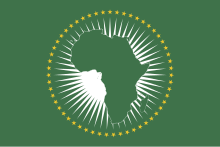Let Us All Unite and Celebrate Together
 | |
Official anthem of the African Union Former anthem of the Organisation of African Unity | |
| Also known as | Arabic: فلنتحد جميعا ونحتفل معا; French: Unissons-nous tous et célébrons ensemble; Portuguese: Vamos todos nos unir e celebrar juntos; Spanish: Unámonos todos y celebremos juntos; Swahili: Tuungane na tusherehekee |
|---|---|
| Lyrics | Tsegaye Gabre-Medhin |
| Music | Arthur Mudogo Kemoli, 1986 |
| Adopted | 1986 (by the Organisation of African Unity) 2002 (by the African Union) |
| Audio sample | |
Let Us All Unite and Celebrate Together (Instrumental) | |
"Let Us All Unite and Celebrate Together" (Arabic: فلنتحد جميعا ونحتفل معا; French: Unissons-nous tous et célébrons ensemble; Portuguese: Vamos todos nos unir e celebrar juntos; Spanish: Unámonos todos y celebremos juntos; Swahili: Hebu wote kuungana na kusherehekea pamoja) is the anthem of the African Union (AU). It was written as a poem titled "Proud to be African" by Ethiopian poet Tsegaye Gabre-Medhin, while the music was composed by Kenyan choral composer Arthur Mudogo Kemoli. It had served as the anthem of the former Organisation of African Unity since 1986 before being adopted by the newly formed Union in 2002.
History[edit]
The anthem was written as a poem titled "Proud to be African" by Ethiopian poet Tsegaye Gabre-Medhin. Kenyan choral composer Arthur Mudogo Kemoli composed the anthem's music in Dakar, Senegal in 1986[1] and it was selected as the anthem of the AU's predecessor, the Organisation of African Unity (OAU), as part of a contest.[2][3] That same year,[a] the OAU honoured Tsegaye with the OAU African Unity Anthem Prize for writing the anthem.[6]
After the AU's formation in 2002, it organised a contest to establish official symbols of the Union, including a flag, emblem and anthem. The competition's brief for the anthem included that its short form for official ceremonies (first stanzas or two verses and chorus) should not exceed one minute in length and that each entry should include lyrics, sheet music, a good recording and an explanatory note and be submitted in one of the working languages of the AU. The brief stated that the symbols should draw inspiration from a number of values including struggle, independence, labour, unity, justice and hope. The competition was to last until 25 April 2003 and the three best entries were to be presented and the symbols chosen at a session of the AU Assembly in Maputo, Mozambique in July 2003 with the first-, second- and third-place winners receiving US$7,000, US$5,000 and US$3,000 cash prizes, respectively.[7][8]
The competition did not attract many participants[7] and eventually, the competition was abandoned and the old OAU symbols were instead retained as the new symbols for the AU,[9] including the OAU anthem, which was retained as the anthem of the new bloc.[2][10][11]
Lyrics[edit]
| English version[12] | Arabic version[12] | French version[12] |
|---|---|---|
I |
I |
I |
| Portuguese version[12] | Spanish version[12] | Swahili version[12] |
|---|---|---|
I |
I |
I |
Notes[edit]
See also[edit]
References[edit]
- ^ "Arthur Mudogo Kemoli". profiles.uonbi.ac.ke. p. 3. Retrieved 2022-01-04.
- ^ a b "Complete National Anthems of the World: 2013 Edition" (PDF). www.eclassical.com. 2012.
- ^ Kabaji, Egara. "Kemoli: the fallen music giant". The Standard. Archived from the original on 2022-01-04. Retrieved 2022-01-04.
- ^ Press Digest. Vol. 13. Anasir Publishers. 2006. p. 7.
- ^ "Ethiopian poet laid to rest in Addis Ababa". www.iol.co.za. Retrieved 2022-01-04.
- ^ "POET LAUREATE TSEGAYE GABRE". www.ethiopians.com. Retrieved 2022-01-04.
- ^ a b "New AU anthem, flag not attracting much interest". The Mail & Guardian. 2003-04-22. Retrieved 2022-01-04.
- ^ "Observatory of Cultural Policies in Africa" (PDF). ocpa.irmo.hr. 2003-02-10. Retrieved 2022-01-04.
- ^ "African Union". fotw.fivestarflags.com. Retrieved 2022-01-04.
- ^ Kidula, Jean Ngoya (2013). Music in Kenyan Christianity : Logooli Religious Song. Bloomington, IN. p. 264. ISBN 978-0-253-00702-5. OCLC 856868782.
{{cite book}}: CS1 maint: location missing publisher (link) - ^ McKinley, Jesse (2006-03-09). "Tsegaye Gabre-Medhin, Ethiopian Poet Laureate, Dies at 69". The New York Times. ISSN 0362-4331. Archived from the original on 2021-12-25. Retrieved 2022-01-04.
- ^ a b c d e f "African Union Anthem" (PDF). www,au.int. Retrieved 2022-01-04.
